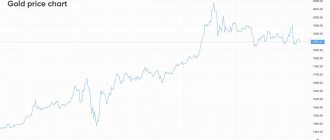Definition and examples from history
A decrease in the general price level is called deflation. This is the opposite of inflation. Economists believe that a price increase of 1–2% per year contributes to economic development, and therefore increases people’s well-being. But their fall, even by 1%, leads to big problems.
People in Japan know why this is bad. In this article we will try to understand the Japanese. This phenomenon has never happened in Russia, and there are no prerequisites for its occurrence yet. You can object to me. According to Rosstat, in August 2021, a price decrease of 0.24% was recorded, and in September – by 0.16%. But this short-term drop is due to a seasonal factor (vegetables and fruits tend to become cheaper at this time of year). On an annual basis, Russia is reaching inflation of approximately 3.5%. And this is a record low value for our country.
History knows significantly fewer examples of deflation than high inflation. The most striking of them:
- The Great Depression in the 30s of the last century in the USA, which also affected Canada and a number of European countries. Prices for agricultural products alone fell by 40–60%.
- Japan's "Lost Decade" This name was given to the period of deflationary collapse from 1991 to 2000, when economic growth stopped and unemployment began to grow at an accelerated pace. It has still not been possible to fully overcome the consequences of the crisis.
Economists also define biflation as when two processes are observed simultaneously in the economy: inflation and deflation. Prices for essential goods and services (food, utilities, etc.) are rising, but prices for goods that are most often purchased on credit (for example, cars, apartments) are falling.
After reading, you will understand how to stop working for pennies at a job you don’t like and start LIVING truly freely and with pleasure!
There are only two types of deflation:
- It is good when a decrease in the price level is associated with the progressive development of production at enterprises, the introduction of new modern technologies, which lead to a reduction in costs and the final price of a product or service for the buyer. This can also be caused by increased competition in the market, when price reduction becomes one of the factors in the struggle for the client. All of the above does not lead to an economic crisis, but, on the contrary, indicates healthy market relations.
- It’s bad when the population’s demand for goods and services decreases for various reasons, which we will discuss later in the article. This, in turn, leads to a reduction in production, jobs, and lower wages.
Let's figure out why deflation is dangerous for the economy. Imagine the situation: you come to the store and see a decrease in prices for your favorite products, and so on from month to month. It’s a dream... Now put yourself in the place of the manufacturer. With each new price decrease, your profit decreases. You are forced to look for ways to reduce costs (expenses), but you won’t be able to do this endlessly, and selling at a loss is not an option. The company's production is being reduced and there is no money for further development.
The economy experiences a recession (downturn), and then a depression (crisis). As a result, both producers and end consumers, that is, you and me, are losers. The danger is also that it is much more difficult to get out of a deflationary crisis than an inflationary one.
The term “deflationary spiral” is known. The mechanism of its action is this: prices fall, but people expect an even greater fall and do not buy goods and services. As a result, production is reduced and the spiral becomes even tighter. Many economists believe that due to the different mentality of citizens of our and other countries, we are not in danger of deflation in the near future. The fact is that any reduction in prices in Russia leads to rush demand for goods.
We do not believe in further decline. We must take it while they give it. Perhaps this will change over time.
Forecast of real estate prices in 2021 in St. Petersburg
What was the real estate market like in 2021?
In St. Petersburg, housing prices began to rise in the second half of 2021. Spending on real estate in the last quarter of 2020 reached its highest level since 2013. The rise in prices on the primary market led to an increase in prices on the secondary housing market, as well as to the fact that apartments at the foundation pit stage became equal in cost to finished housing. Click on the picture to enlarge it.
Housing in St. Petersburg has always become more expensive. To be convinced of this, just look at the price dynamics over recent years. But in the second half of 2021, there was a price jump. The increase in prices for new buildings in the city since the beginning of 2021 amounted to 25%, according to analytics, in the region - 20%, outpacing the increase in prices in the country as a whole. It is difficult to remember anything similar in the last ten years. This is an absolute record in the real estate market.
Such a rise in price comes as a shock to the consumer, since he was not prepared for such rapid market growth. This fact has a bad effect on purchasing power and the real estate market in general.
Reasons for the rise in price
Preferential mortgage for new buildings
Experts call preferential mortgages at 6.5% in new buildings one of the factors contributing to the rise in price of square meters in new buildings. Everyone knows that preferential mortgages will not always be valid; they have certain validity periods. Many buyers decided that they should not miss the chance. Perhaps, if there were no preferential mortgages, many would have postponed the purchase of a home until better times. Thus, preferential mortgages acted as a catalyst in the real estate market.
Growing demand
Of those who rushed to buy, there were many people who simply wanted to save savings from ongoing inflation. The reduction in deposit rates and the deterioration of the general economic situation led to people panicking; they began to withdraw money from bank accounts and invest it in currency, cryptocurrency, precious metals and real estate. What do they buy first? People consider studios and one-room apartments, rooms for further renting out as the most attractive in terms of investment.
Availability of buyers
St. Petersburg real estate is always in demand. There are buyers in the city whose income level allows them to purchase real estate. Many buy for children “for growth”, some as an investment. St. Petersburg real estate is also in demand among nonresidents; it is purchased by residents of the regions, as well as the CIS. Real estate is popular among residents of Ukraine, Belarus and Kazakhstan. Some people buy it for themselves, many buy it for their children-students.
What could the developers offer?
And there weren’t many liquid offers on the market. After the adoption of amendments to Federal Law 214 in 2021, qualitative changes occurred in the real estate market of St. Petersburg. The main innovation of the reform - the participation of banks in the construction process - led to an increase in the cost of construction in general. According to the new reform, the developer must build not with the money of the shareholder, but with his own or borrowed funds. Only very large developers have their own funds for the construction of several projects; most have borrowed funds. This fact leads to an increase in the cost of construction, because loans need to be paid.
Is it profitable for a developer, under the given conditions, to build liquid mass-market housing? Apparently, it is more profitable to build more expensive housing. Apparently, for this reason, the number of more expensive objects, comfort plus and business class has increased. Elite properties began to appear in ordinary areas of the city, which was not the case before.
An example is the elite-class housing project “Institutsky 16” in the Vyborg region, where the price for a one-room apartment at the foundation pit stage started at 16 million rubles. Previously, such objects were built in the historical part of the city, in the Petrogradsky, Admiralteysky districts, on Krestovsky Island, where business and elite class housing is traditionally built.
As popular and inexpensive offerings began to disappear from the market, there was a shortage of supply in this sector. In addition, many developers have slowed down sales due to the pandemic. The decline in affordable housing construction is one reason why housing costs have soared.
Increase in construction costs
Is this a cause or an effect? On the one hand, the rise in construction costs is a consequence of the transition of the construction market to project financing. On the other hand, the rise in construction costs in general has led to an increase in the cost per square meter.
The pandemic also did its dirty work. First, due to closed borders and the general instability of the economic situation, prices for building materials increased. Then there was a mass exodus of migrants from Central Asia in the spring and summer of 2021. As a result, there was a labor shortage. Labor costs have risen by 25-30%. Jumping exchange rates did not improve the situation.
The shortage of plots for construction in the central areas of the city and the entry of expensive properties into the market are additional factors for the rise in housing prices.
Rising housing prices in different sectors by level of comfort
In 2021, prices for mass market (economy class) housing increased by approximately 25%. The rise in prices has led to the blurring of the line between new buildings at the foundation pit stage, with a completion date of several years, and the finished housing market. It is clear that it is better to choose ready-made housing, move in and live, than to wait for it for several years.
According to an analytical report for December 2021, the cost of housing in the business class segment increased by 19%. The average cost of one square meter in this segment was 205 thousand rubles per meter. In the premium class (luxury housing) these figures are even higher, which is explained by the fact that there are fewer offers in this segment. In the premium class, the figure for the year increased by 34% and amounted to 297 thousand rubles per square meter.
What the experts say
There has been another price hike in the real estate market. Will prices drop to their previous levels? Will the market return to its previous positions? Hardly. I don’t remember a case in recent years when there was a decrease in prices after a price jump.
While there are few objective reasons for the reduction, there are several reasons for the price increase:
1. The change to Federal Law 214 has come into full force. The transition of construction from equity to project financing continues; in 2020, about 40% of real estate under construction is real estate under construction under the new law. This affects the pricing of housing under construction. 2. Preferential mortgage. 3. Inflation and devaluation. The fall in the ruble exchange rate. Introduction of a tax on bank deposits over 1 million rubles. 4. Sanctions and the unhealthy political and economic situation in general.
Real estate price forecast in 2021
A review of the real estate market suggests that the increase in housing prices that began in 2021 is likely to continue smoothly in 2021. I really want to hope for a reduction in prices, but there are no economic prerequisites for optimism. This is sad, since rising prices usually lead to stagnation in the real estate market.
Conclusions:
The unstable economic and political situation in Russia, sanctions, the pandemic and the contraction of the real sector of the economy have led to an increase in prices in the real estate market.
What will happen next? The real estate market is influenced by the political and economic situation in the country, government bills, and household income.
The most important factors in the rise in housing prices, in my opinion, are economic – the devaluation of the ruble and political – the general uncertainty in the country. The unknown and fear of the future pushed people to buy housing in the fall of 2021. Many buyers were confident that if they did not have time to buy a home, they would not be able to buy it in the future due to a sharp rise in price. Therefore, they took out loans and bought mainly inexpensive housing. Their fears were justified; housing prices rose from August to December and became unaffordable for people with low incomes.
As for the forecast for 2021, a lot depends on what the construction industry offers us in 2021 and what actions the government takes. The big question is the preservation of consumer demand, namely the preservation of the level of income of the population. Will real estate prices fall? The cancellation of the preferential mortgage program could seriously affect the construction industry market. If the mortgage is canceled, demand will fall, so there is a possibility of prices falling, but in my opinion there will not be a significant reduction in prices.
At the beginning of 2021, demand decreased slightly due to a decrease in interesting offers, as well as an increase in prices. Incomes of the population do not grow and solvency remains at the same level at best. Few people can afford the sharply increased prices for housing in St. Petersburg.
It is becoming increasingly difficult for people from the regions to buy real estate in St. Petersburg, since the difference in prices in the regions and St. Petersburg has become much more noticeable. If a couple of years ago you could buy a one-room apartment in the city at the pit level for 4 million rubles, now one-room apartments in new buildings at the pit level cost from 6–8 million rubles, depending on the class of housing. The cost of apartments on the secondary market is rising to the level of the cost of new buildings. It remains, as before, to cast glances towards the outskirts and nearest suburbs of the Leningrad region, where more cheap and inexpensive housing is being built.
In my reasoning, I proceed from my experience and knowledge, without pretending that my opinion is the ultimate truth.
Good luck! Galina Cherkis
Buying a mortgaged apartment
Real estate investing
Causes
The main reason for deflation is the imbalance between supply and demand. Let's look at what can lead to this:
- Overproduction is when enterprises produce goods without coordinating this process with the demand of the population. As a result, surpluses form in warehouses, and attempts are made to sell them cheaper. If it works out, good. If not, then there is a decrease in further production and all the ensuing consequences: a reduction in labor force, wages, etc.
- Oddly enough, stability in the economy. It is still difficult to imagine this in Russia, but Europeans may already see the harbingers of deflation. In a stable and predictable economy, the population is interested in saving money for long-term goals (on deposits, in a safe). Money does not enter the real sector, does not participate in circulation, thereby increasing its value. This is in contrast to inflation, which decreases the value of money. Enterprises are lowering prices in an attempt to attract buyers, and they are spiraling.
- Excessive measures to combat inflation. High rates of depreciation of the money supply force the government and the Central Bank to adopt strict regulatory methods. An incorrectly chosen tactic can lead to a change from inflationary processes to deflationary ones.
- Inflating “financial bubbles,” for example, stock exchange (speculative) or currency bubbles. The population, seeing an increase in the value of securities or the depreciation of their own currency, begins to actively invest free money in the purchase of shares or foreign currency, hoping to earn even more. The bubble bursts and the market collapses.
- Wrong credit policy. Excessive tightening of requirements for issuing loans to both enterprises and the population leads to a decrease in the volume of lending. And this again leads to a decrease in consumer demand, the rate of production development and deflation.
There can be only one reason, or several may be involved at once.
The danger of a price war
When competitors deliberately lower prices, this leads to a decrease in profits. There have already been many price wars, but none of them ended positively. The result in all cases is the same: in a certain niche, profits decreased, key players left altogether, new players appeared who attracted customers with something more than just a low price.
The logic of such wars is simple:
- A competitor cuts prices - you do the same in response - but the competitor cuts them again.
- Reducing prices does not reduce costs, but reduces profits.
- Low profits limit investment in product development, for example, in good advertising or service, which brings the company's growth to a standstill.
- Costs increase, prices remain low, and the company earns less and less. In the future, you will come to a decision to leave the market.
- If you reduce prices once, it will be difficult to increase them later.
Sometimes the low price is justified. For example, you are the only one in the market who has access to cheaper resources or have introduced new technology that leads to savings.
First way: high quality and high service win
If a competing company maintains low prices, most likely the quality of its product or service leaves much to be desired. Let's turn this disadvantage into our advantage:
- Increase your product with new features and properties.
- Supplement your service with a new service.
- Update your packaging or develop a new one that is different from your competitors.
- Introduce a truly individual approach to your clients.
- Improve your warranty.
Second method: increase profitability per client
It's better to get one client who will generate income than 10 new ones who will not bring it. Put profit first, not quantity:
- Focus on clients who are willing to pay more for better results.
- Buyers who are not interested in the result will always choose what is cheaper.
- Offer your customers to buy additional service or services, expand their purchasing power.
Third method: temporary price reduction promotions
Unlike permanent price declines, stocks are effective because of their temporary nature. They will help you:
- If you want to respond to a competitor’s price reduction: gives time to develop new ideas;
- Incentive for a new purchase: the client tries the product and evaluates the result.
Types of shares:
- Temporarily reducing prices to or below the competitor's level: the incentive to try the product increases.
- Promotions of 50% discount for 3 days work better than 10% discount for a month.
- Longer deferment of payment if we are talking about wholesale purchases.
- Discount for repeated purchase of a product or a discount for purchasing 2 products: more income per customer.
- Gift Baskets.
- You give a gift or bonus for a purchase.
Fourth method: introduce a low-price offer into the assortment
If you manage your product range correctly, you can satisfy customers on a massive scale. Enter a product or service that will cost the same as a competitor.
Such an offer will have fewer functions than your main product, and this can explain the lower cost. It may even have fewer functions than competitors, but it is the low price that will attract the right competitors.
Fifth way: increase the duration of brand use
When competitors dump, they need a constant increase in customers. Make it more difficult to obtain new consumers - increase the duration of use of the product or service:
- Subscription fee: enter a subscription for a year or six months at an attractive price.
- Everyday product: run promotions with a frequency equal to the frequency of purchases of this product. Every time a customer comes to your store, they will choose your brand because it is on discount.
- Durable goods: individual purchase conditions. For example, car brands offer to exchange an old car for a new one.
Sometimes this is enough for competitors to reconsider their pricing policy.
Sixth method: impossibility of comparing prices
The buyer chooses a cheaper product if it is possible to compare the price. If there is no such opportunity, then there will be nothing to choose from:
- Service package - add a service that cannot be priced.
- Add an accessory to your product.
- Add new features that differentiate you from your competitors.
- Make your products have a unique taste or aroma.
Remember that constant monitoring of competitors' prices is an opportunity to promptly learn about changes in the market and respond correctly to them.
As practice shows, this way you can only achieve short-term success; dumping will not help you gain leadership positions in the long term.
We offer you 5 solutions that will help you combat the problem of competitors cutting prices. This will help you avoid a price war, strengthen your position and attract new customers.
Consequences
The consequences of deflation in the economy stem from the reasons for its formation:
- A decrease in production volumes, therefore, a reduction in enterprise profits. This, in turn, leads to a freeze in their investment activities, an increase in unemployment and a decrease in household incomes, which does not contribute to an increase in demand for goods and services. The money supply shrinks and economic growth stops.
- Saving and accumulative behavior of the population also leads to a decrease in money in circulation, a reduction in demand and a decrease in production volumes.
- A too sharp reduction in the Central Bank's key rate may lead to the fact that it will simply become unprofitable for the population to keep money on deposits, and banks will have nothing to issue loans from. The latter are going bankrupt en masse, public confidence in the banking sector is falling, lending is falling even further, and the deflationary spiral is tightening.
The final consequence of the above is one thing – economic recession and crisis.
Control measures
There is even a special term for government policy aimed at combating deflationary phenomena - reflation. The main measures include:
- If the volume of lending falls, it needs to be stimulated. This can be achieved through a more loyal attitude towards borrowers and lowering loan rates. The main thing is not to go too far, otherwise the situation will turn out when the economy is flooded with credit money received by insolvent borrowers. Cheap loans for enterprises mean revitalizing production, developing new areas of development, and producing more competitive products. For the population to borrow money at lower rates means an increase in demand for expensive goods.
- Government investment in large infrastructure projects (roads, bridges, pipelines, subsoil exploration, etc.). Dozens of enterprises from different sectors of the economy are involved in such large-scale events. In a crisis, they will have full capacity utilization, an influx of labor and profits. It is projects like this that can pull the country out of any hole. The construction industry alone pulls behind it more than 70 other sectors of the economy.
- Reduced taxes for businesses and organizations. By itself, this measure is unlikely to lead to a way out of the deflationary crisis, but together with others it will help cope with the negative consequences. For example, the released funds can be used to invest in the development of new industries, the products of which are more in demand among the population.
- Increasing the volume of issue of government securities, for example, bonds. This will allow the population to park their free money in a reliable investment instrument and count on profits (coupons). And the state will have the opportunity to spend funds taken from citizens on additional measures to combat deflation.











